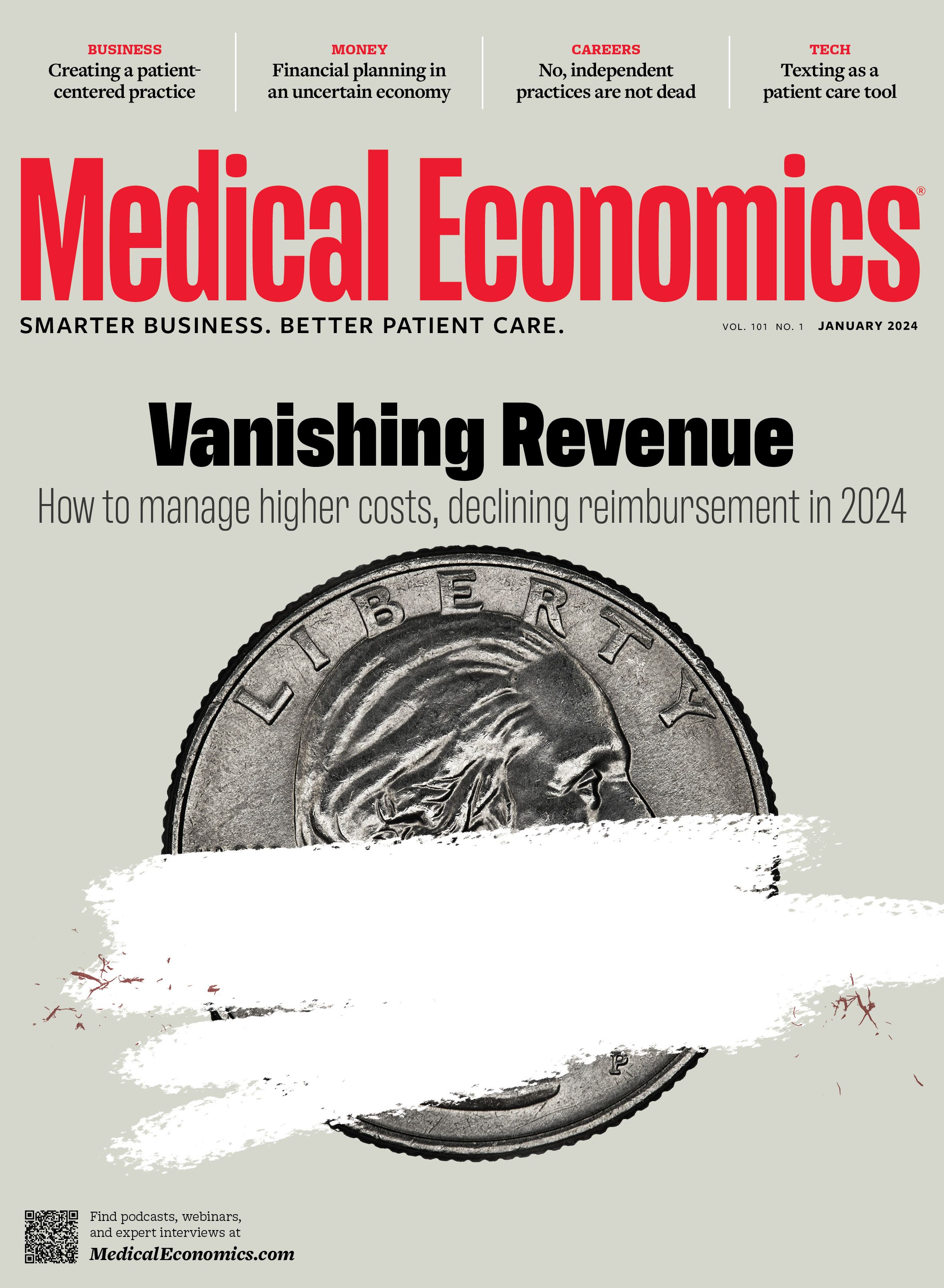News
Article
Medical Economics Journal
2024 Physician Payment Outlook: How to manage higher costs, declining reimbursement
Author(s):
Financial strategies for physicians in 2024
Managing declining reimbursement in 2024

Although most employees had wage gains in 2023 in the range of 4% with about the same increase projected for 2024, physicians, for the most part, have seen nothing but reimbursement decreases.
Following a 2% cut in the Medicare Physician Fee Schedule in 2023, doctors will see another 3.37% cut to the conversion factor in 2024. The reduced reimbursement comes during an economic environment in which inflation has hovered around historic highs, good employees are difficult to find, and patients are expecting more and more from their physicians in terms of convenience and service.
Private payers have their own financial pressures, which can lead to additional demands on doctors and their staff.
“They’re trying to navigate increasing costs, increasing infrastructure, COVID-19 — all the things that they have to deal with day to day — but also lower reimbursement,” according to Madison Davidson, an associate principal with health care consulting firm Avalere. “As the trend continues in Medicare, private payers are using that as a benchmark, and even if their payment may be greater in dollars, it’s still that similar trend of decreasing over time.”
The upcoming year looks to be full of financial challenges for doctors. Here is what physicians need to know about reimbursement for 2024 and beyond.
Physician Fee Schedule cut … again
Cuts to the Medicare Physician Fee Schedule haven’t become a question of if they will happen, but rather a matter of how much they will be cut by. Everyone, including most members of Congress, knows the cuts are devastating to doctors and could start to threaten the viability of the program if physicians stop accepting Medicare, but changes are difficult to make in a polarized government.
Anders Gilberg, senior vice president, government affairs, for the Medical Group Management Association, says that although Congress is
looking to reduce the cut, physicians would still be facing a 2% reduction to the conversion factor. For primary care physicians, Centers for Medicare & Medicaid Services (CMS) will implement G2211, an add-on code for office and other outpatient services for more complex visits, in 2024, but although it sounds good, it doesn’t do much to change the financial picture.
“The complex 2211 visit is something that is supported by primary care and is aimed at helping increase reimbursement rates for primary care physicians,” Gilberg says. “Unfortunately, given its budget neutrality impact, that is a significant part of why there’s a conversion factor cut.”
In other words, where primary care gains with the additional code, it loses it with the overall conversion factor cut, and these continual cuts are affecting patient care and access.
“There’s like a head-in-the-sand mentality that we’re seeing out there,” Gilberg says. “For example, the Medicare Payment Advisory Commission has put out a report saying that there isn’t an access problem in Medicare, yet we have primary care practices telling us that if they do accept new Medicare patients, new patient visits are 250 days out. Yes, they take Medicare, yes, they have some availability, but that availability may be 250 days in the future.”
Gilberg says that other practices report that even when they are open to Medicare patients, trying to make referrals to specialists who are accepting new patients is becoming challenging.
“While most physicians participate in Medicare for payment purposes, they certainly are not necessarily having the ability to just take every and all Medicare beneficiaries in a timely manner,” Gilberg says.
In addition to the fee schedule cut, the 3.5% Advanced Alternative Payment Model incentive expired. The fee was reduced to 3.5% for 2023 and now will be zero for 2024.
“That was something that originally was a 5% add-on for those medical practices and physicians who had participated in an Advanced Alternative Payment Model — it was a bonus on their fee-for-service payments,” Gilberg says.
There is some good news for physicians, mainly in what CMS did not implement: an increase to the performance threshold in the Merit-Based Incentive Payment System (MIPS) from 75 points to 82 points.
“It would have created winners and losers based on their MIPS score, and over 50% of physicians would have received a cut if CMS had increased that to 82 points,” Gilberg says. “But in the end, they maintained the performance threshold that existed [in 2023], so it’s now again at 75 points.”
In addition, telehealth will be reimbursed at a higher rate that brings it on par with an in-person visit, at least through 2024.
Is value-based care fading?
Value-based care was once considered an inevitable destination for all payers and physicians as a means to control costs while focusing on better care for patients. Predictions of the demise of fee-for-service payment models have been common in recent years, but surveys show that most reimbursement is still occurring under the fee-for-service (FFS) model.
“Our members report that value-based care has kind of stalled out,” Gilberg says. “At least in terms of Medicare, there aren’t a lot of new alternative payment models being put forth, so many specialties outside of primary care don’t have alternative payment models to participate in. The incentives are going down. There’s just general concern among our membership and as a whole that CMS isn’t providing and continuing to evolve its value-based payment offerings.”
In fact, the Center for Medicare and Medicaid Innovation, the government agency tasked with producing new cost-saving models, actually increased federal spending between 2011 and 2020 and is expected to continue to increase spending through 2030, according to a report from the Congressional Budget Office. The report asks the question of whether value-based care can produce savings, at least in Medicare.
“With the expiration of that 3.5% bonus, I think it’s going to be all that harder for those practices that haven’t moved to value-based care to even move,” Gilberg says.
As Medicare struggles to implement value-based care programs that save money, experts say that private payers are still looking to move more contracts away from FFS. The difference for private payers is that they tend to have a younger and healthier population than Medicare, so it’s easier for them to find savings.
“There was a feeling that the transition to value-based care would be quicker than it has been,” says Christi Skalka, a managing director at Deloitte Consulting. “For hospitals, one challenge has been resistance from hospital CFOs [chief financial officers] to give up what is perceived to be lucrative fee-for-service revenue. There is also a perception that payers hold the upper hand in total-cost-of-care analytics, given their closed claims set of data, and that payers are not interested in partnering in attribution models.”
Skalka says the shift to value-
based care can be very market specific — some geographic markets have hit the tipping point, primarily due to one of the large health systems figuring out how to make money with it, pushing the rest of the market to capitulate in negotiations to stay in network.
Hospitals, health systems and physicians are all seeing downward pressure on FFS rates and a general unwillingness by payers to cover inflationary cost increases beyond historical cost-of-living adjustments.
“The downward pressure on FFS is happening and there are no increases in sight, forcing physician practices to either downsize — which you can only do so much — take less in compensation or join a larger organization such as a health system to seek protection from these payer issues,” says Howard Drenth, a managing director at Deloitte Consulting. “Given that more than half of physicians are employed by either a health system or other large health services organization or private equity, they are seeking relief from the FFS pressure while the transition to value takes place.”
Davidson agrees, adding that payers are still trying to figure out what the best payment models look like.
“There have been a lot of lessons learned, and I don’t think there’s been a ton of great success stories with value-based care,” Davidson says. “But at the same time, we can’t keep going on the fee-for-service path.”
As physicians consolidate in larger organizations to cope with declining reimbursement, Gilberg points to CMS as causing some of its own problems. By keeping the conversion factor flat over the past several years, CMS has inadvertently caused some of the consolidation among practices, affecting costs.
“The policies that we’re seeing that are keeping physician payments flat and then driving physicians into larger systems are then creating systems that are, theoretically at a macro level, more costly to the overall system,” Gilberg says.
Maximizing payments
With so many financial factors working against physicians, experts say that they need to do everything possible to maximize their payments by showing their value to payers. Although there is a shortage of physicians that would seem to favor doctors in negotiations via supply-and-demand economics, that isn’t much of a factor.
“I think that high-quality physician services — for example, great outcomes — is a bigger driver of leverage with payers than just the overall number of physicians,” Skalka says. “High-cost, low-value physicians will not be able to negotiate as well. Additionally, building a case for better or sustained reimbursement with comparative performance metrics, patient satisfaction scores, and regional or market-based rate benchmarks through price transparency will help physicians in negotiations.”
She adds that being open to incentive-based reimbursement will show a willingness to collaborate with payers on their goal of reducing costs in the overall health care ecosystem.
Payers are looking for proof of better outcomes with data and performance metrics, and when physicians can provide this, it helps them in negotiations.
“Physicians will also need to demonstrate that they can properly manage the patient panel they have been assigned as well as ensure they have good patient access and quality reporting,” Drenth says.
Davidson says practices absolutely need to have data to prove their value. “I think having that data to present a value story to payers is very valuable because then your plans can work on making you a preferred partner,” she says. “It’s not necessarily limiting access to others but making sure that they can direct their members to practices with high-value care.”
This may require an investment in technology to boost patient care and operational efficiency and includes things such as a revenue cycle management system, telehealth and an improved patient financial experience. These technologies can provide detailed reports to the practice that can be used to its advantage.
“Using this reporting to show excessive administrative burden of medical policies by payers can help in building the case for increased reimbursement,” Skalka says.

Newsletter
Stay informed and empowered with Medical Economics enewsletter, delivering expert insights, financial strategies, practice management tips and technology trends — tailored for today’s physicians.





